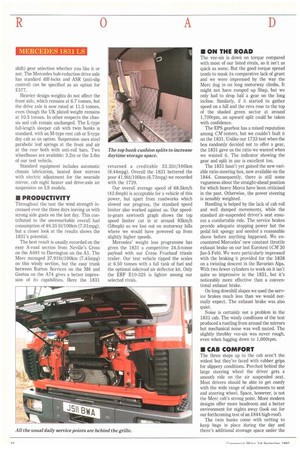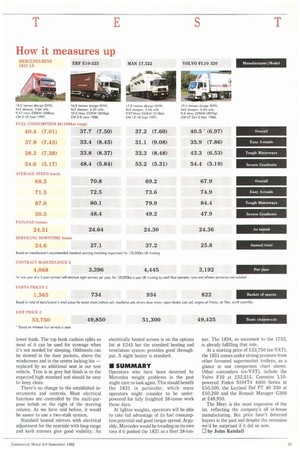Price: 256,073 (ex-VAT). Includes £1,729 for side and roof deflector kit ; 2594 for constant throttle exhaust brake.
Page 32

Page 34

Page 35

If you've noticed an error in this article please click here to report it so we can fix it.
Engine: 9.57 litres, 230kW (308hp).
GCW: 38.0 tonnes.
Payload: 24.51 tonnes.
Speed: 68.5km/h (42.6mph).
Fuel consumption: 40.41it/100km (7.01mpg).
The Mercedes heavy truck engine range was all at sixes and sevens, or rather sixes and eights, until earlier this year. There wasn't the logical progression most rival manufacturers have, where the least powerful engines have the smallest capacity and the fewest cylinders. The 213kW (290hp) 1729 was powered by a hulking great naturally aspirated 15-litre vee-eight, while the next model up the power range, the 243kW (326hp) 1733, used a lighter charge-cooled 11-litre veesix. But then the EC Euro-1 emissions legislation sounded the death knell for big, naturally aspirated engines like the 1729's,
With the introduction of the 1733 two years ago, Mercedes was already laying the foundation for a family of engines with many common design features. For example, the vee-six engine shared the same 90° configuration, bore and stroke as the larger vee-eight. Mercedes announced its Low Emission Vehicle (LEV) engine programme late last year to meet the Euro-1 emissions regulations. By introducing a smaller bore and stroke to the same blocks, M-B created two new engines in the range, now dubbed LEV 400. The 12.8-litre vee-eight is rated at 280kW (375hp); the 9,57-litre vee-six is rated at 180kW (241hp), 200kW (268hp) and 230kW (308hp). At the same time the company raised its design weights to accommodate the forthcoming increases in gross weights across Europe. Consequently, twoaxle tractive units are prefixed with 18 and three-axle tractive units with 25, instead of the previous 17 and 24.
The 1831, successor to the 1729, uses the smaller vee-six in its most powerful form. Power is increased by 8% and torque by 22%. This should enhance its fleet appeal, particularly as the lighter vee-six lops 700kg off the gross weight. Our test of the 1733 (CM 21-27 June 1990), showed that the larger 10.96-litre vee-six could return respectable fuel consumption and fast journey times. Would a bit less power and torque make that much difference?
• PRODUCT PROFILE
The "little" vee-six produces 230kW (308hp) at 2,100rpm and 1,340Nm (9881bft) of torque at 1,250rpm. The torque curve rounds off between about 1,100rpm and 1,600rpm, offering good potential flexibility.
In terms of capacity, power and torque the Merc vee-six corresponds closely to Volvo's TD102P 9.6-litre lump fitted in the F10/FL10. The Volvo in-line six produces 229kW (313hp) at 2,050rpm and 1,290Nm (9501bft) of torque at 1,200rpm.
To meet the Euro-1 limits, several changes have been incorporated in Mercedes LEV 400 engines since the 1733 appeared.
Apart from charge-cooling, they all have five-hole injector nozzles, a high-pressure injection pump, revised combustion chamber design with a higher (16.75:1) compression ratio and a flame-starting unit to reduce white smoke from a cold start. Our test vehicle was also fitted with Mercedes new constant-throttle exhaust brake, an expensive option at £594, but worth considering if you operate in hilly country.
Like all Mercedes Powerliner 2 tractors, you get Mercedes' 16-speed rangechange and splitter box with EPS (electronic power shift) gear selection whether you like it or not. The Mercedes hub-reduction drive axle has standard diff-locks and ASR (anti-slip control) can be specified as an option for 577.
Heavier design weights do not affect the front axle, which remains at 6.7 tonnes, but the drive axle is now rated at 11.5 tonnes, even though the UK plated weight remains at 10.5 tonnes. In other respects the chassis and cab remain unchanged. The L-type full-length sleeper cab with twin bunks is standard, with an M-type rest cab or S-type day cab as an option. Suspension uses steel parabolic leaf springs at the front and air at the rear both with anti-roll bars. Two wheelbase:4 are available: 3.2m or the 3.6m of our test vehicle.
Standard equipment includes automatic chassis lubrication, heated door mirrors with electric adjustment for the nearside mirror, cab night heater and drive-axle air suspension on LS models.
• PRODUCTIVITY
Throughout the test the wind strength increased over the three days leaving us with strong side gusts on the last day. This contributed to the unremarkable overall fuel consumption of 40.35 lit/100km (7.01mpg), but a closer look at the results shows the 1831's potential.
The best result is usually recorded on the easy A-road section from Neville's Cross on the A691 to Darrington on the Al. The Mere managed 37.91lit/100km (7.45mpg) on this windy section, but the easy trunk between Burton Services on the M6 and Gretna on the A74 gives a better impression of its capabilities. Here the 1831 returned a creditable 33.51it/100km (8.44mpg). Overall the 1831 bettered the poor 41.91it/100km (6.72mpg) we recorded with the 1729.
Our overall average speed of 68.5km/h (42.6mph) is acceptable for a vehicle of this power, but apart from roadworks which slowed our progress, the standard speed limiter also worked against us. Our speedin-gears sawtooth graph shows the top speed limiter cut in at around 93km/h (58mph) so we lost out on motorway hills where we would have powered up from slightly higher speeds.
Mercedes' weight loss programme has given the 1831 a competitive 24.5-tonne payload with our Crane Fruehauf triaxle trailer. Our test vehicle tipped the scales at 6.50 tonnes with a full tank of fuel and the optional side/roof air deflector kit. Only the ERF E10-325 is lighter among our selected rivals.
• ON THE ROAD
The vee-six is down on torque compared with most of our listed rivals, so it isn't as quick as some. But the good torque spread tends to mask its comparative lack of grunt and we were impressed by the way the Mere dug in on long motorway climbs. It might not have romped up Shap, but we only had to drop half a gear on the long incline. Similarly, if it started to gather speed on a hill and the revs rose to the top of the shaded green sector at around 1,700rpm, an upward split could be taken with confidence.
The EPS gearbox has a mixed reputation among CM testers, but we couldn't fault it on the 1831. Unlike our 1733 test when the box randomly decided not to offer a gear, the 1831 gave us the ratio we wanted when we wanted it. The indicator showing the gear and split in use is excellent too.
The 1831 hasn't yet gained the new variable ratio steering box, now available on the 1844. Consequently, there is still some vagueness about the straight-ahead position for which heavy Mercs have been criticised in the past. Otherwise, the power steering is sensibly weighted.
Handling is helped by the lack of cab roll and well damped movements, while the standard air-suspended driver's seat ensures a comfortable ride. The service brakes provide adequate stopping power but the pedal felt spongy and needed a reasonable shove before anything happened. We encountered Mercedes' new constant throttle exhaust brake on our last Eurotest (CM 30 Jan-5 Feb). We were particularly impressed with the braking it provided for the 1838 on a twisting descent in the Bavarian Alps. With two fewer cylinders to work on it isn't quite so impressive in the 1831, but it's noticeably more effective than a conventional exhaust brake.
On long downhill slopes we used the service brakes much less than we would normally expect. The exhaust brake was also quiet.
Noise is certainly not a problem in the 1831 cab. The windy conditions of the test produced a rustling from around the mirrors but mechanical noise was well muted. The slightly throbby vee-six was never rough, even when lugging down to 1,000rpm.
• CAB COMFORT
The three steps up to the cab aren't the widest but they're faced with rubber grips for slippery conditions. Perched behind the large steering wheel the driver gets a smooth ride on the air suspended seat. Most drivers should be able to get comfy with the wide range of adjustments to seat and steering wheel. Space, however, is not the Mere cab's strong point More modern designs offer more headroom and a better environment for nights away (look out for our forthcoming test of an 1844 high-roof).
The twin bunks come with netting to keep bags in place during the day and there's additional stowage space under the lower bunk. The top bunk cushion splits so most of it can be used for stowage when it's not needed for sleeping. Oddments can be stowed in the door pockets, above the windscreen and in the centre locking bin replaced by an additional seat in our test vehicle. Trim is in grey but finish is to the expected high standard and should be easy to keep clean.
There's no change to the established instruments and controls. Most electrical functions are controlled by the multi-purpose kebab on the right of the steering column. As we have said before, it would be easier to use a two-stalk system.
Standard heated mirrors with electrical adjustment for the nearside with long-range and kerb mirrors give good visibility. An electrically heated screen is on the options list at £245 but the standard heating and ventilation system provides good throughput. A night heater is standard.
• SUMMARY
Operators who have been deterred by Mercedes weight problems in the past might care to look again. This should benefit the 1831 in particular, which many operators might consider to be underpowered for fully freighted 38-tonne work these days.
At lighter weights, operators will be able to take full advantage of its fuel consumption potential and good torque spread. Arguably, Mercedes would be treading on its own toes if it pushed the 1831 as a fleet 38-ton
ner. The 1834, as successor to the 1733, is already fulfilling that role.
At a starting price of £53,750 (ex-VAT), the 1831 comes under strong pressure from other favoured supermarket trolleys, as a glance at our comparison chart shows. Other contenders (ex-VAT), include the Volvo F10 at £52,515, Cummins L10powered Foden S104T4 4000 Series at £50,500, the Leyland Daf FT 80 330 at £50,260 and the Renault Manager G300 at £48,950.
The Merc is the most expensive of the lot, reflecting the company's all in-house manufacturing. But price hasn't deterred buyers in the past and despite the recession we'd be surprised if it did so now.
0 by John Kendall




































































































